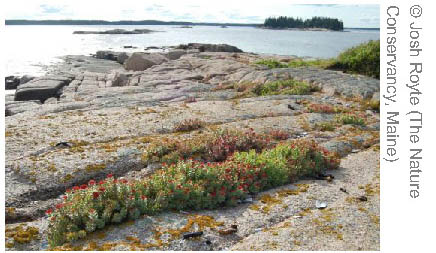The Rocky coast macrogroup consists of the following habitats:
Acadian-North Atlantic Rocky Coast


Regional distribution:
CT, MA, ME, NH, NY, RI. 7,706 total acres of habitat, of which 16.6% is conserved.
Description:
An open rocky shoreline found in the narrow zone between the high tide line and the upland wooded areas. These intertidal zones of solid rock are often covered with seaweeds that tolerate extremes of exposure to winds, waves, currents, and ice-scour. Blue-green algae are common in the high intertidal zones; barnacles in the mid- intertidal zone; mussels in the lower intertidal. Diagnostic species include seaweeds (Irish moss, rockweed, knotted wrack, hollow-stemmed kelp) and invertebrates (blue mussels, common periwinkles, dogwhelks, and springtails). Tide pools provide nurseries for lumpfish, sea snails, pollock, and other fish. Many bird species frequent these: purple sandpiper, ruddy turnstone, sanderling, black-bellied plover, American oystercatcher, and pectoral sandpiper.
Download the
pdf for this habitat for information about species, crosswalks to state names, and condition of this habitat.